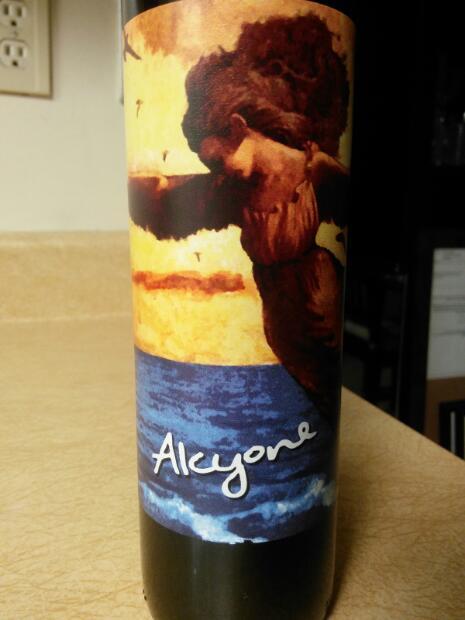
External search
Google (images)
Wine Advocate
Wine Spectator
Burghound
Wine-Searcher
Vintages
2020
2017
2015
2014
2013
2011
2010
2009
2008
2007
N.V.
From this producer
Show all wines
All tasting notes
|
| Drinking Windows and Values |
| Drinking window: Drink between 2016 and 2022 (based on 7 user opinions) |
| Community Tasting History |
| Community Tasting Notes (average 90 pts. and median of 91 pts. in 4 notes) - hiding notes with no text | | | Tasted by christianminer on 3/17/2021 & rated 92 points: This dessert wine is made from 100% tannat and combines two dessert wine production methods. As with Ports and Marsala the fermentation of the wine is stopped with the addition of Brandy. This means that not all the grapes sugars have been converted to alcohol and the wine retains a natural sweetness. The Alcyone also follows the Barolo Chinato method by flavoring the wine with herbs and spices. The resulting drink has a radiant purple hue and honey like texture. Flavors of Madagascan vanilla bean and a hit of cherries, dark chocolate, blueberries and spice with a long velvety finish. (218 views) | | | Tasted by JuLyon on 1/2/2021 & rated 91 points: Very dark unctuous wine with a bouquet and taste that lasted for ages and somehow reminded me of the bottom half of a trifle - sponge soaked in Sherry with red berry fruits. Went exceptionally well with a dark chocolate dessert. (220 views) | | | Tasted by sburtt on 2/27/2019 & rated 86 points: Blinded. I was guessing Spain/Portugal or possibly new world, felt like it had substantial bottle age (very forward) and a lot of oak on the nose. Wow I was surprised it was so young and didn't know this grape from Uruguay. Apparently there is not oak, but it's the natural scents of the grape to give this effect. This is something a bit different from usual, not really my style (486 views) |
| Viņedo de los Vientos Producer websiteTannat Varietal character (Appellation America) | Wikipedia
A southern French variety, it's most commonly found in the southwest part of the country near the Pyrenees. Characteristically, it has hard tannins, raspberry aromas, and a fair amount of astringency. Given those tannins, it's successful as the base for French roses, where tannins are minimized by little skin contact. In blends, particularly in California, Tannat adds bite to what might otherwise be flabby or soft wines resulting from overripe grapes.
Wine from the Tannat grape is typically rough and tannic when young, but with aging will mature into a full-bodied red wine. Modern winemaking in France (Madiran appellation) has begun to emphasize the fruit more and utilize barrel aging to help soften the tannins, with the wines typically spending about twenty months in oak prior to bottling.
The Tannat vine was introduced in Uruguay by Basque settlers in the 1870s and began to flourish as it readily adapted to the local soil and climate. Today it is often blended with Pinot Noir and Merlot, and is made in a variety of styles including those reminiscent of Port and Beaujolais. Although considered Uruguays national grape, Tannat is also grown in Argentina, Australia, Brazil and in Italy's Puglia region where it is used as a blending grape.
Tannat wines produced in Uruguay are usually lighter in body and lower in tannins than those from France. In France, efforts to solve the harsh tannic nature of this grape led to the development of the winemaking technique known as micro-oxygenation. Vineyards in Uruguay have begun to distinguish between the "old vines" that are descendants from the original European cuttings and the new clones introduced in the 1990s. The newer vines tend to produce more powerful wines with higher alcohol levels but less acidity and complex fruit characteristics, although some wineries utilize both vines to make blends.
First brought to the US late in the 19th century by a UC Berkeley agricultural professor, Tannat plantings did not receive much attention until the 1990s when California producers, most notably in the Santa Cruz Mountains and Paso Robles viticultural areas, began using it in blends with Cabernet Franc, Sangiovese and Syrah. In 2002, the Bureau of Alcohol, Tobacco and Firearms formally recognized Tannat as a separate varietal.
In the vineyard, Tannat is one of the easiest varietals to grow, ripening late and being frost hardy. Unlike other varietals, it is not prone to overproduction and so does not require thinning. The grapes berries have thick skins, which make it resistant to powdery mildew and botrytis, and which contributes to the varietals naturally high tannins. One notable difficulty with growing Tannat is its thick stems, which cling tightly to the berries and can be difficult to remove at harvest.
Tannat has significantly higher polyphenol content than other red grapes, making it the most bioactive variety with regards to oxidative reactions in food. Doctors have recommended Tannat as being the best wine grape for cardiopulmonary health because it contains a large amount of the antioxidant procyanidin, a chemical which helps bolster blood vessels and increase oxygen flow to red blood cells, ultimately helping to avert cardiovascular disease.
Tannat makes decidedly robust wines, with pronounced aromas of tobacco smoke, plum or ripe berries. The wines also tend to be dense purple-red in color, with significant tannins and a wonderfully spicy finish. Notable California producers include Bonny Doon Vineyards in the Santa Cruz Mountains and Tablas Creek Vineyards in Paso Robles.Uruguay Wines of Uruguay (Asociaciķn de Bodegas Exportadoras de Vinos Finos del Uruguay) |
|




